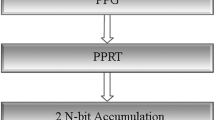Abstract
The need for hard (3X) multiple generation in radix-8 booth encoding increases the complexity of partial product generation and the latency of the multiplier. The source of delay is primarily the propagation of carry signals. A variety of carry propagate adder architectures have been studied to overcome this drawback. In this paper, we propose a hybrid adder architecture that precomputes the simultaneous generation of pseudo carry signals by exploiting the symmetry of 3X multiple and the final carry generation using Ling prefix network. As the Ling adder in the carry path reduces the complexity, the proposed adder results in significant improvement in the power delay product (\({\sim }\)25–55%) compared to state of the art 64 bit adders. This adder decreases the number of logic gates in the critical path, leading to a reduction in static power consumption. As a design metric, it is necessary to minimize the energy dissipation of logic modules, the results indicate that the proposed hybrid adder would fulfil the requirements of processors in deep sub-micron VLSI technology.




Similar content being viewed by others
References
MacSorley, O.L.: High speed arithmetic in binary computers. Proc. IRE 49, 67–91 (1961)
Booth, A.D.: A signed binary multiplication technique. Q. J. Mech. Appl. Math. 4, 236–240 (1951)
Madrid, P.E., Millar, B., Swartzlander Jr., E.E.: Modified Booth algorithm for high radix fixed point multiplication. IEEE Trans. VLSI Syst. 1, 164–167 (1993)
Dawoud, D.S.: Modified Booth algorithm for higher radix fixed-point multiplication. In: Proceedings of South African Symposium on Communications and Signal Processing, pp. 95–100 (1997)
Parhani, B.: Computer Arithmetic Algorithms and Hardware Designs. Oxford University Press, New York (2000)
Kogge, P.M., Stone, H.S.: A parallel algorithm for the efficient solution of a general class of recurrence equations. IEEE Trans. Comput. 22(8), 786–792 (1973)
Ruiz, G.A., Granda, M.: An area-efficient static CMOS carry-select adder based on a compact carry look-ahead unit. Microelectron. J. 35(12), 939–944 (2004)
Ladner, R.E., Fisher, M.J.: Parallel prefix computation. J. ACM 27(4), 831–838 (1980)
Brent, R.P., Kung, H.T.: A regular layout for parallel adders. IEEE Trans. Comput. 31(3), 260–264 (1982)
Han, T., Carlson, D.: Fast area-efficient VLSI adders. In: Proceedings of IEEE Symposium on Compuer Arithmetic, pp. 49–56 (1987)
Knowles, S.: A family of adders. In: Proceedings of the 14th IEEE Symposium on Computer Arithmetic, pp. 30–34 (1999)
Sklansky, J.: Conditional sum addition logic. IRE Trans. Electron. Comput. 9, 226–231 (1960)
Becker, B., Kolla, R.: On the construction of optimal time adders. In: Proceedings of the 5th Annual Symposium on Theoretical Aspects of Computer Science (STACS’88), pp. 18–28. Springer, New York (1988)
Lo, Jien-Chung: A fast binary adder with conditional carry generation. IEEE Trans. Comput. 46, 248–253 (1997)
Cheng, K.-H., Cheng, Shun-wen: Improved 32 bit conditional sum adder for low-power high speed applications. J. Inf. Sci. Eng. 22, 975–989 (2006)
Ruiz, G.A., Granda, M.: Efficient implementation of 3X for radix-8 encoding. Microelectron. J. 39(1), 152–159 (2008)
Bewick, G., Flynn, M.J.: Binary Multiplication Using Partially Redundant Multiples. CSLTR-92-528. Computer Systems Laboratory, Stanford University, Stanford (1992)
Pettenghi, H., Pratas, F., Sousa, L.: Method for designing efficient mixed radix multipliers. Circ. Syst. Signal Process. 33, 3165–3193 (2014)
Ling, H.: High speed binary adder. IBM J. R & D 25, 156–166 (1981)
Dimitrakopoulos, G., Nikolos, D.: High-speed parallel-prefix VLSI ling adders. IEEE Trans. Comput. 54(2), 225–231 (2005)
Grad, J., Stine, J.E.: A hybrid ling carry select adder. In: Conference record of 38th Asilomar Conference on Signals, Systems, and Computers, vol. 2, pp. 1363–1367 (2004)
Doran, R.W.: Variants of an Improved carry look ahead adder. IEEE Trans. Comput. 37, 1110–1113 (1988)
Vazquez, A., Antelo, E.: New insights on ling adders. In: International Conference on Application—Specific Systems, Architectures and Processors, pp. 227–232 (2008)
Burgess, N.: Implementation of recursive Ling adders in CMOS VLSI. In: Proceedings of 43rd Asilomar Conference on Signals, Systems, and Computers, pp. 1777–1781 (2009)
Juang, T.-B., Meher, P.K., Kuan, C.-C.: Area-efficient parallel-prefix Ling adders. In: Proceedings of IEEE Asia Pacific Conference on Circuits and Systems (APCCAS), pp. 736–739 (2010)
Bart, R., Zeydel, D.B., Oklobdzija, V.G.: Energy-efficient design methodologies: high-performance VLSI adders. IEEE J. Solid State Circ. 45(1), 1220–1233 (2010)
Wang, L., Song, W., Liu, P.: Link the remote sensing big data to the image features via wavelet transformation. Cluster Comput. 19(2), 793–810 (2016)
Yang, C., Chi, P., Song, X., Lin, Yu., Li, B.H., Chai, X.: An efficient approach to collaborative simulation of variable structure systems on multi-core machines. Cluster Comput. 19(1), 29–46 (2016)
Author information
Authors and Affiliations
Corresponding author
Rights and permissions
About this article
Cite this article
Nirmaladevi, R., Seshasayanan, R. Energy efficient parallel hybrid adder architecture for 3X generation in radix-8 booth encoding. Cluster Comput 22 (Suppl 5), 10709–10716 (2019). https://doi.org/10.1007/s10586-017-1162-3
Received:
Revised:
Accepted:
Published:
Issue Date:
DOI: https://doi.org/10.1007/s10586-017-1162-3




